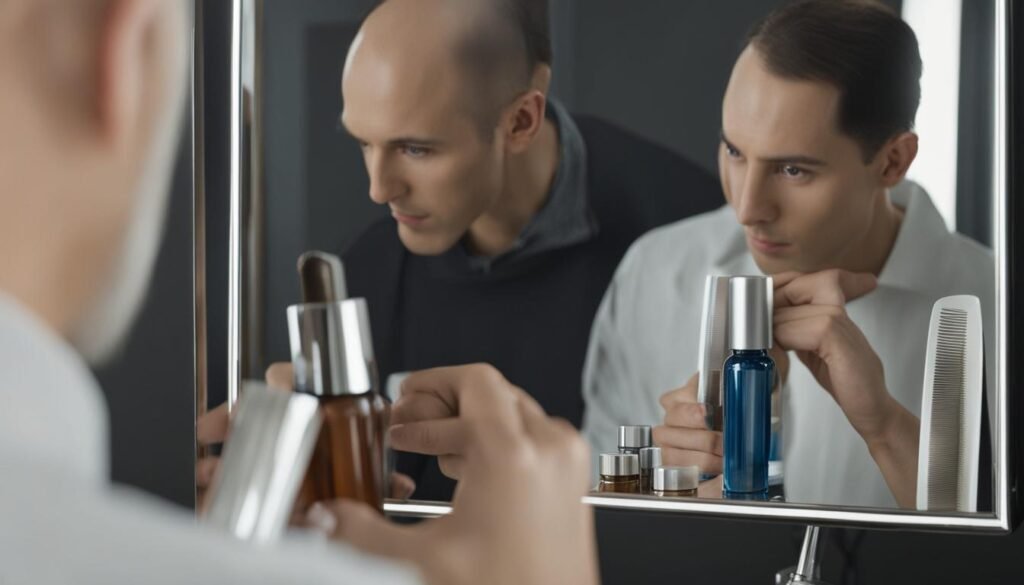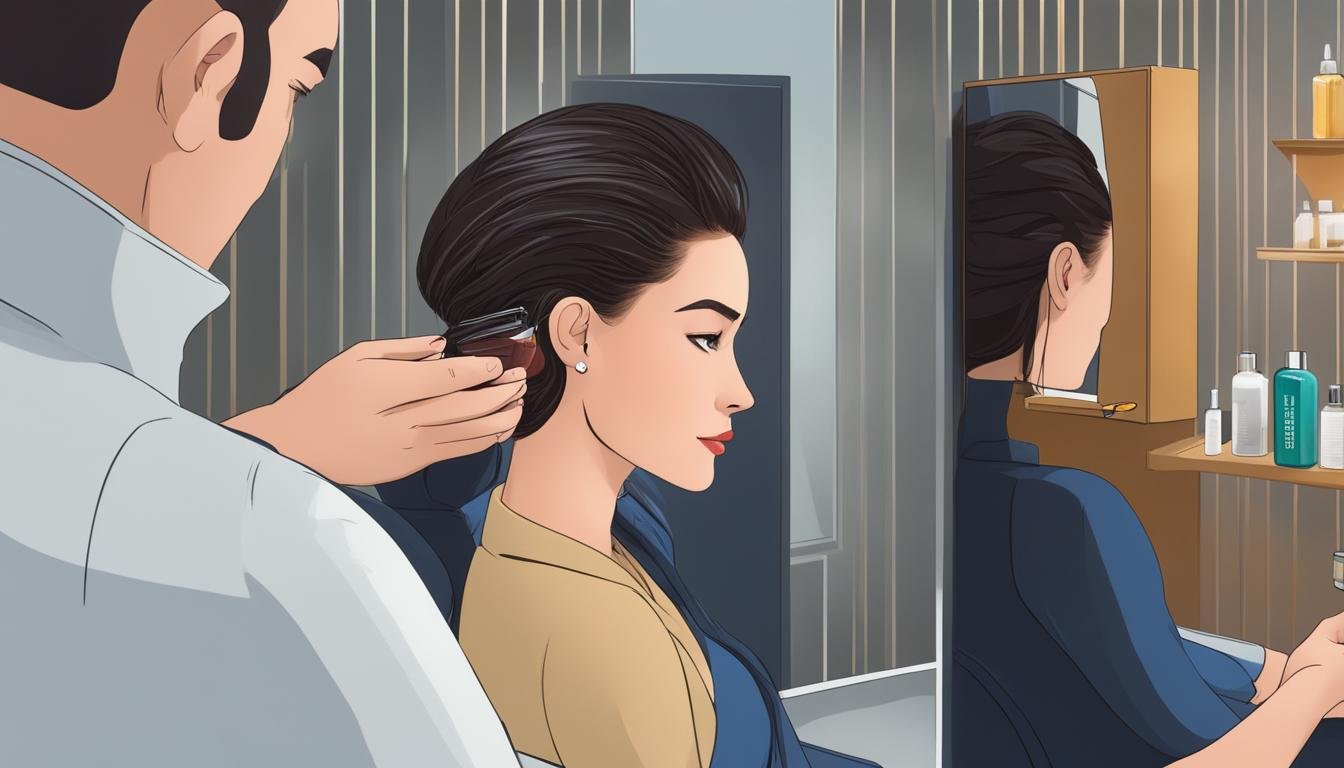Are you noticing a difference in hair thickness between the two sides of your scalp? Don’t worry, you’re not alone. Many people experience hair thinning or hair loss that affects only one side of their head. But what could be causing this uneven hair thickness?
Understanding the causes of one-sided hair loss is essential in finding the right solutions for regaining your hair’s health and promoting growth. Several factors can contribute to this condition, including genetics, stress, sickness, hormonal imbalances, and inflamed scalp.
Other potential causes include autoimmune conditions like alopecia areata, impulse control conditions like trichotillomania, trauma, hairstyles, and treatments that cause scalp irritations, as well as other medical conditions.
Identifying the specific cause is the first step towards effective treatment. By addressing the underlying issue, it’s possible to restore hair health and achieve a more even hair thickness.
There are various treatments available, such as medications like minoxidil, natural remedies, and scalp massage and stimulation. Additionally, reducing stress and considering cosmetic interventions like scalp micro-pigmentation can provide further options for managing one-sided hair loss.
If you’re concerned about your hair thinning on one side, keep reading to discover common causes, effective treatments, and tips for managing uneven hair thickness.
Common Causes of One-Sided Hair Loss
One-sided hair loss, also known as asymmetrical hair thinning, can occur due to various factors. Understanding the common causes can help identify the underlying issue and guide the appropriate treatment. The following are some of the most prevalent causes of one-sided hair loss:
- Genetics: Inherited genes can play a significant role in hair loss patterns, including uneven hair thinning.
- Stress: Emotional or physical stress can lead to hair loss, and it may affect one side of the scalp more prominently.
- Sickness: Certain illnesses or medical conditions can cause hair thinning, particularly on one side of the head.
- Irregular Hair Development: Abnormal hair growth patterns can result in one-sided hair loss or bald patches.
- Hormonal Imbalances: Fluctuations in hormone levels can disrupt the hair growth cycle, leading to asymmetrical hair loss.
- Inflamed Scalp: Scalp inflammation, often due to conditions like seborrheic dermatitis or psoriasis, can contribute to one-sided hair thinning.
- Autoimmune Conditions: Disorders like alopecia areata, where the immune system mistakenly attacks hair follicles, can cause localized hair loss.
- Trichotillomania: This impulse control disorder causes individuals to compulsively pull out their own hair, commonly resulting in asymmetrical hair loss.
- Trauma: Physical trauma, such as injuries or surgical procedures, can cause hair loss that affects one side more than the other.
- Hairstyles and Treatments: Certain hairstyles that exert tension on specific areas of the scalp or harsh treatments can lead to one-sided hair thinning.
- Other Medical Conditions: Various underlying medical conditions, such as hormonal imbalances, circulatory problems, or specific medications, can contribute to asymmetrical hair loss.
Identifying the specific cause of one-sided hair loss is crucial in determining the most effective treatment approach. A thorough evaluation by a healthcare professional or dermatologist is recommended for accurate diagnosis and personalized treatment plans.
How to Treat One-Sided Hair Loss
To effectively treat one-sided hair loss, it is crucial to identify the underlying cause. This process may involve consulting with a medical professional or dermatologist to accurately diagnose the issue. Once the cause is determined, targeted treatments can be implemented to address the root of the problem rather than solely focusing on symptom management.
Treating one-sided hair loss may involve a combination of medical interventions, natural remedies, and lifestyle modifications. It is important to approach the treatment holistically, supporting not only the affected hair but also the overall health of the scalp and follicles.
Find the Cause
Identifying the cause of one-sided hair loss is the first step towards effective treatment. Possible causes include genetics, hormonal imbalances, scalp inflammation, autoimmune conditions, traumatic events, or certain hairstyles and treatments that cause scalp irritation.
Treat the Issue at Its Source
Once the cause is determined, treatment options can be tailored to address the specific issue. For example, if hormonal imbalances are the root cause, hormone therapy or medications like minoxidil may be prescribed. If scalp inflammation is to blame, anti-inflammatory treatments or scalp care products may be recommended.
Support Your Hair’s Overall Health
Optimizing your hair’s overall health can help promote hair growth and reduce further thinning. This can be achieved through several measures:
- Adopting a healthy diet rich in vitamins, minerals, and proteins that support hair health.
- Using quality hair care products that nourish and strengthen the hair.
- Regularly massaging the scalp to stimulate blood flow and promote hair follicle health.
A healthy scalp creates a conducive environment for hair growth.
Cosmetic Interventions and Natural Treatments
In some cases, cosmetic interventions like scalp micro-pigmentation can provide a temporary solution by creating the appearance of thicker hair. This technique involves tattooing tiny dots on the scalp to mimic the look of hair follicles.
Natural treatments can also be incorporated into the treatment plan. For example, scalp massage and stimulation with oils like rosemary or coconut oil can stimulate hair growth and improve overall scalp health.

| Treatment Options | Pros | Cons |
|---|---|---|
| Medications (e.g., minoxidil) | – May promote hair regrowth – Widely available |
– Potential side effects – Requires consistent use |
| Natural Remedies (e.g., onion juice, ginseng) | – Fewer potential side effects – Can be easily incorporated into a hair care routine |
– Results may vary – Requires patience and consistency |
| Scalp Micro-pigmentation | – Provides the appearance of thicker hair – Non-surgical solution |
– Temporary solution – May require maintenance |
It is important to note that the effectiveness of these treatments may vary depending on the individual and the underlying cause of the one-sided hair loss. Consulting with a medical professional or dermatologist is crucial to receive personalized advice and guidance.
Tips for Managing Uneven Hair Thickness
Managing uneven hair thickness can be challenging, but there are several tips that can help.
- Accept that it’s normal: Variations in hair thickness are common and natural. Instead of feeling frustrated or self-conscious, embrace and celebrate your unique hair texture.
- Avoid tension on the thinner side: Be mindful of your styling habits and avoid putting excessive tension on the thinner side of your hair. This means avoiding hairstyles that pull tightly on one side or constantly brushing or combing one side more than the other.
- Switch up sleep positions: Changing your sleep positions can help improve blood flow to the scalp and reduce friction on the thinner side. Consider using silk or satin pillowcases, which are gentler on the hair and can help prevent breakage.
- Change your hair routine: Experiment with different hairstyles and techniques that place less tension on your hair. Avoid overstyling or overusing heat styling tools, as they can further damage the thinner side of your hair. Opt for low-tension styling methods and use heat protectant products when necessary.
- Consider medical-grade wigs: In some cases, managing uneven hair thickness may require the use of medical-grade wigs. These wigs can provide a temporary solution while allowing your natural hair to rest and recover. Speak to a professional hairstylist or dermatologist for guidance on finding the right wig for your needs.
Remember, managing uneven hair thickness is a journey that requires patience and experimentation. By implementing these tips and being gentle with your hair, you can promote healthier hair growth and feel more confident in your unique hair texture.
Expert Tip:
“When managing uneven hair thickness, it’s important to listen to your hair and give it the care it needs. Be gentle with your hair, avoid harsh treatments, and consider seeking professional advice for personalized guidance and solutions.” – Dr. Rachel Johnson, Trichologist
Hair Care Products for Managing Uneven Hair Thickness
| Product | Description | Benefits |
|---|---|---|
| Hair Thickening Shampoo | A shampoo formulated to add volume and thickness to the hair. | Provides a temporary boost in hair thickness, adds volume, and improves overall appearance. |
| Scalp Stimulating Serum | A serum that stimulates the scalp and promotes hair growth. | Enhances blood circulation to the scalp, nourishes hair follicles, and supports healthier hair growth. |
| Leave-In Conditioner | A conditioning product that is left on the hair without rinsing. | Helps moisturize and soften the hair, reducing breakage and improving manageability. |
| Detangling Brush | A brush designed to detangle the hair without causing excessive breakage. | Gently removes tangles and knots, minimizing hair breakage on the thinner side. |
Try incorporating these hair care products into your routine to help manage uneven hair thickness effectively.
Patience and Time for Hair Growth
When it comes to hair growth and managing uneven hair thickness, patience is key. Achieving the desired results takes time and consistent effort. It’s important to remember that hair growth is a gradual process and overnight transformations are unrealistic.
Improving blood flow to the scalp is crucial for promoting healthier hair growth. Regular scalp massages and steam sessions can help stimulate blood circulation, nourishing the hair follicles and encouraging hair growth.
Changing your sleeping position can also make a difference. Consider using silk or satin pillowcases to reduce friction and prevent hair breakage. This simple change can improve blood circulation to the scalp, supporting better hair growth.
Additionally, it’s important to switch up your hair routine and avoid putting unnecessary tension on the thinner side. Experiment with different hairstyles and low-tension styling methods to give your hair a break from constant stress. By providing gentle care, you create an optimal environment for hair growth.
If you’re looking for a temporary solution or an instant boost in confidence, medical-grade wigs can be a great option. These wigs offer comfort and a natural appearance while allowing your hair to rest and recover. However, it’s important to keep in mind that medical-grade wigs are not a long-term solution for hair growth.
Remember, significant progress takes time. Be patient with your hair and give it the attention and care it needs. With consistent efforts and healthy hair practices, you can achieve the hair growth you desire.
Source Links
- https://www.allisonmctigue.com/blog/hair-loss-on-one-side-of-head-causes-amp-treatments
- https://www.naturallycurly.com/curlreading/how-tos-styles/what-you-should-do-if-one-side-of-your-hair-is-thinner-than-the-other/
- https://www.sistersletter.com/style/hair-thinning-on-one-side-heres-what-may-be-causing-it
